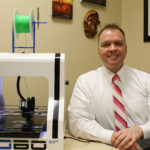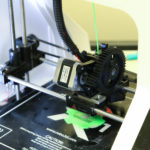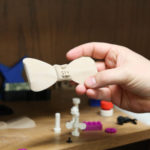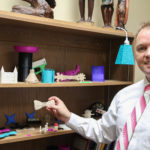In a world that is dominated by technology, it is no surprise that companies seek out tech-savvy individuals to hire into the workplace.
The Goddard School of Business at Weber State University is adding a new course to their program in order to give students an edge in 3-D printing and prototyping skills that can be used in the real world.
Jeff Clements is an assistant professor of information systems and technologies at The Goddard School of Business and Economics. Clements has been working for the past few months on a new course focusing on 3-D printing and prototyping.

The CRN for the new course will be IST 4720 and the class itself is called Emerging IT. The current prerequisite is IST 3110, however, Clements thinks that in the future a prerequisite won’t be needed.
“It will give students a chance to explore what rapid prototyping and 3-D prints are all about,” Clements said.
According to Clements, this technology will have major implications in the business world, which includes changing how goods are manufactured. With 3-D printers readily available, it is now possible for businesses to take an idea and immediately begin work on a prototype. The process from taking an idea to a physical, tangible model can now be completed in a matter of days.
Clements said that students won’t be required to have a thorough understanding of engineering or design in order to take the class.
“They can come in with an idea and not (know) how to make it happen,” Clements said. “And then we teach them to design, print and refine it.”

The Goddard School of Business and Economics currently has four 3-D printers, including a printer that is able to print multiple materials and dual-colored objects.
Jeff Steagall, the current Dean of the Goddard School, has been on board with the new course from the beginning.
“I think it’s really exciting,” Steagall said. “It’s a cool technology that we can (do) things with that just ten years ago you could only do in factories.”
Steagall believes this course will help prepare students for the real-world experience they will face after graduation and increase their ability to thrive in the job market.
“We think (the course) is going to be really popular,” Steagall said.

Currently companies such as Nike, Adidas and UPS are already using this technology to enhance their business.
“There’s a lot of changes coming from this new technology and the class will explore a lot of those different things,” Clements said.
Randy Boyle, an assistant professor at the business school, has been working alongside Clements to get the new course up and running.
“We want to offer innovative classes that are non-traditional IST curriculum,” Boyle said.
Boyle believes that this class will offer students marketable skills that will add to their earnings potential when they’re out in the real world. Boyle also mentioned that although other schools may have the same technology, unlike Weber State University, they are not currently teaching their students how to use them.
“Students with zero engineering background can create these really interesting objects without years of training,” Boyle said.

Clements believes that the course will help students to think of business and prototyping in a new and different way.
“And hopefully, it’ll inspire students to start a company and give them the courage to do something great.” Clements said.
For more information about the Goddard School of Business and Economics and their new course, visit their website at http://www.weber.edu/goddard.







